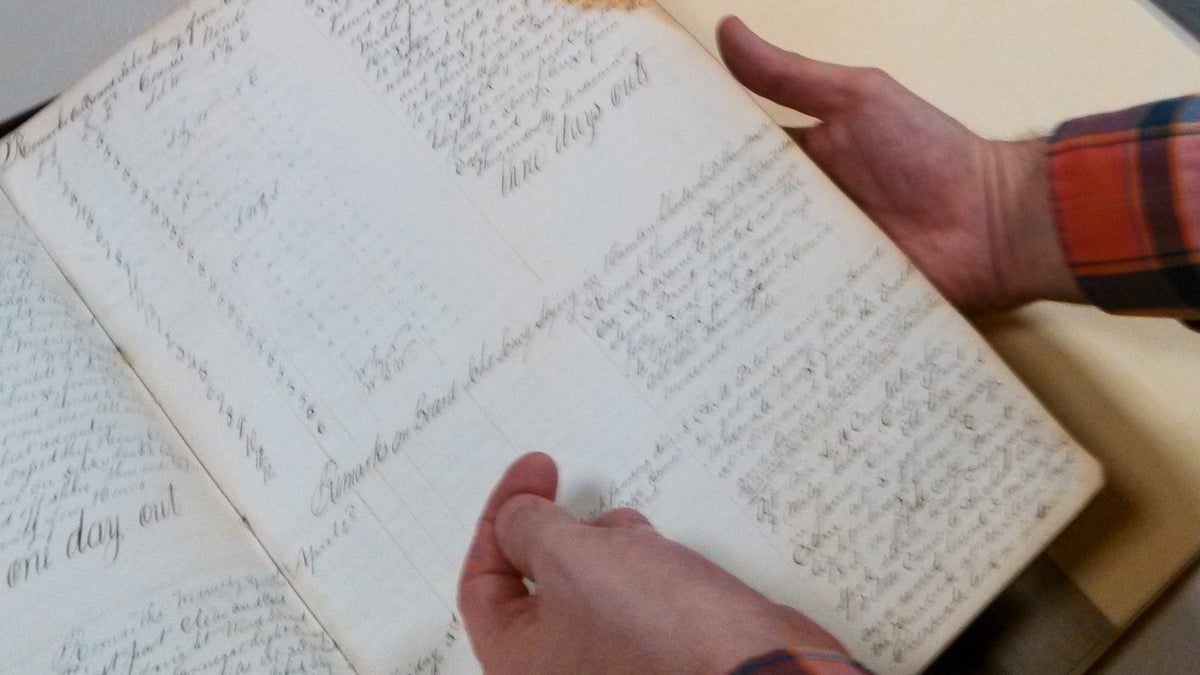Creating a new use for old weather logs
Listen
Craig Bruns of the Independence Seaport Museum flips through an old weather log book. (Kimberly Haas/for The Pulse)
How ships’ weather records, dating back 250 years, are helping to predict future weather patterns.
You’ve probably heard it a dozen times this season:
‘This is the snowiest winter in 30 years,’ or ‘It’s the coldest January on record.’
But all those measures of extreme weather always come with a qualifier: “since we’ve been tracking it,” and it goes back maybe 50 years or so. But a much richer collection of weather data is now being mined, and it comes from an unlikely source. On a recent visit to the Independence Seaport Museum, chief curator Craig Bruns took me back into the archives.
“This one is dated 1850,” says Bruns.
We’re leafing through the log books that every ship, whether military or private, keeps for each voyage it makes. Included on every page is an hour-by-hour account of the day’s weather.
“Sailors are very keen observers of the weather, says Bruns. “They keep track of these weather observations, to know where the winds are. Without that, you’re not going anywhere.”
Bringing old records back to life
This goldmine of data has turned an unlikely department of the Federal government into a bunch of climatologists. Most people think of the National Archives as the nation’s attic, where the old records that are no longer used, are sent to collect dust.
“The diligent recording of meteorological data, dating back 150 years and stored on our shelves, can once again be used for scientific research and analysis,” says Mark Mollan, a Navy-maritime archivist at the National Archives. “That helps us to understand some of the most pertinent issues of the day.”
He and his colleagues have teamed up with the National Oceanic and Atmospheric Administration – NOAA –on a project they’re calling “Old Weather.” They’re transcribing the Archives’ collection of ships’ weather logs, starting with Arctic voyages and going back to the mid-19th century. It’s a huge job. The project’s leader, Kevin Wood, is a research scientist with NOAA and the University of Washington.
“The logs have 24 hourly observations,” says Wood. “So that’s quite a few numbers on every page: barometric pressure, temperature, wind speed, wind direction, cloud cover, sea surface temperature.”
Lest you think it’s just all charts and numbers, there are lots of little surprises in those very detailed books. Craig Bruns at the Independence Seaport Museum showed me how the personality of the authors often shines through across the centuries.
“Here’s one seaman who drew pictures of ships in the margins,” Bruns says. “Look, this captain has a page with little newspaper clippings, jokes.”
The National Archives’ Mark Mollan also notes the lost art of handwriting on display in the log books.
“The penmanship of the time is very striking,” says Mollan. “A lot of beautiful penmanship on those pages.”
At this point you might be thinking, this seems more like a history lesson than a science project. As the database grows, Mark Mollan says the scientists at NOAA start taking over.
“They’re able to create weather patterns and see how weather patterns in the Arctic may have affected wind patterns off the coast of Africa and then how those wind patterns in turn affect the east coast with hurricanes,” says Mollan.
How you can play a role
So where do citizen scientists come in? Well, the initial digitization included half a million images from the ships’ logbooks. The only way it’ll all get done is with the help of volunteers, who currently number about 12,000 worldwide. Kevin Wood says it’s a tough assignment, but also a rewarding one.
“It’s a challenging task that we’re asking folks to help us with,” he says. “There’s a learning curve, but then you’re able to do something that really contributes meaningfully to our ability to understand climate in the past and in the future as well.”
Old Weather volunteers sign up and select a ship whose logs they’d like to help transcribe. You become a “crew member” and collaborate with other volunteers working on that ship’s records, creating a fresh new use for old weather.
For information on other citizen science projects near you, go to scistarter.com.
WHYY is your source for fact-based, in-depth journalism and information. As a nonprofit organization, we rely on financial support from readers like you. Please give today.



